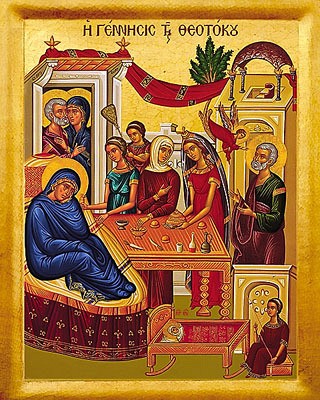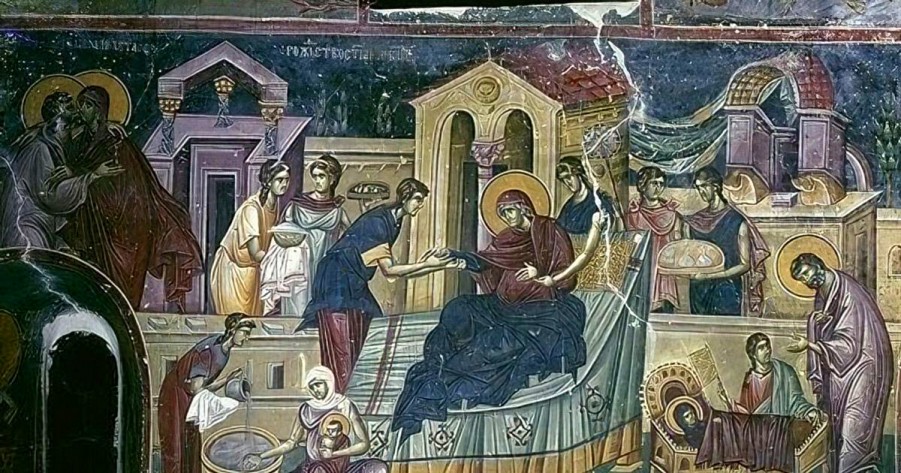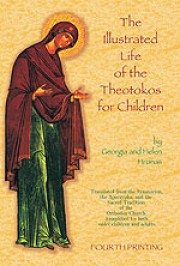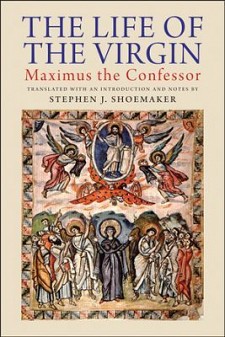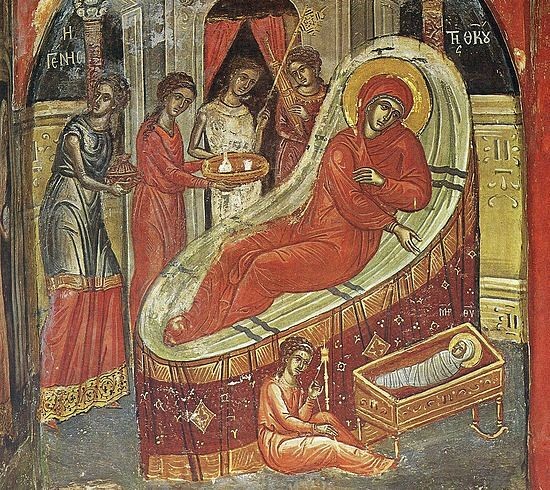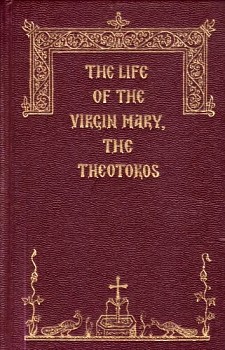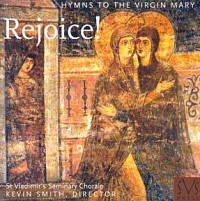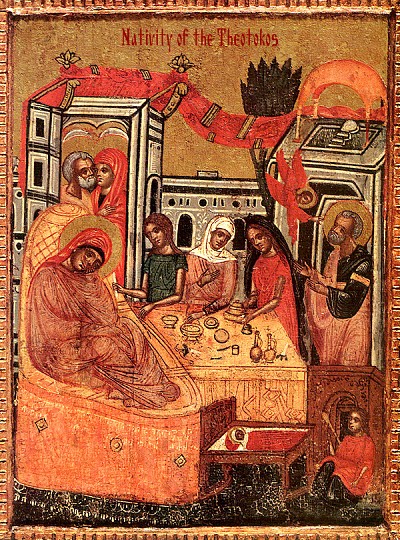NATIVITY of the MOTHER OF GOD
Troparion - Tone 4
Your Nativity, O Virgin,
Has proclaimed joy to the whole universe!
The Sun of Righteousness, Christ our God,
Has shone from You, O Theotokos!
By annulling the curse,
He bestowed a blessing.
By destroying death, He has granted us eternal Life.
Kontakion - Tone 4
By Your Nativity, O Most Pure Virgin,
Joachim and Anna are freed from barrenness;
Adam and Eve, from the corruption of death.
And we, your people, freed from the guilt of sin,
celebrate and sing to you:
The barren woman gives birth to the Theotokos,
the nourisher of our life!
The Prologue from Ohrid
The Holy Virgin Mary was born of aged parents, Joachim and Anna. Her father was of the lineage of David, and her mother of the lineage of Aaron. Thus, she was of royal birth by her father, and of priestly birth by her mother. In this, she foreshadowed Him Who would be born of her as King and High Priest. Her parents were quite old and had no children. Because of this they were ashamed before men and humble before God. In their humility they prayed to God with tears, to bring them joy in their old age by giving them a child, as He had once given joy to the aged Abraham and his wife Sarah by giving them Isaac.
The Almighty and All-seeing God rewarded them with a joy that surpassed all their expectations and all their most beautiful dreams. For He gave them not just a daughter, but the Mother of God. He illumined them not only with temporal joy, but with eternal joy as well. God gave them just one daughter, and she would later give them just one grandson-but what a daughter and what a Grandson! Mary, Full of grace, Blessed among women, the Temple of the Holy Spirit, the Altar of the Living God, the Table of the Heavenly Bread, the Ark of God’s Holiness, the Tree of the Sweetest Fruit, the Glory of the race of man, the Praise of womanhood, the Fount of virginity and purity-this was the daughter given by God to Joachim and Anna. She was born in Nazareth, and at the age of three, was taken to the Temple in Jerusalem. In her young womanhood she returned again to Nazareth, and shortly thereafter heard the Annunciation of the Holy Archangel Gabriel concerning the birth of the Son of God, the Savior of the world, from her most-pure virgin body.
The Nativity of the Most-holy Mother of God
O greatly desired and long awaited one,
O Virgin, thou hast been obtained from the Lord with tears!
A bodily temple of the Most-holy Spirit shalt thou become,
And shalt be called Mother of the Eternal Word.
The Burning Bush they called thee,
For thou wilt receive within thyself the divine fire:
Ablaze with fire but not consumed,
Thou shalt bear the Golden Fruit and offer it to the world.
Thou shalt be the Bearer of Him Who bears the heavens,
To Whom all of heaven offers up praise!
The Miracle of miracles shall come to pass within thee,
For thou shalt bear heaven, thou who art “more spacious than the heavens!”
Thou art more precious to us, O Virgin, than precious stones,
For thou art the source of salvation for mankind.
For this, may the entire universe glorify thee,
O Most-holy Virgin, O white Turtledove!
The King of Heaven shall desire to enter the world,
And shall pass through thee, O Beautiful Gate!
O Virgin, when thou dost become woman thou shalt bear Christ for us;
From thy body, the Sun shall blaze forth.
The importance of this feast, the first in the Church calendar year (which begins September 1) is that it was the first step in preparing mankind for its promised salvation.
From: Missionary Leaflet # E50
Copyright © 1999 and Published by
Holy Protection Russian Orthodox Church, Los Angeles, CA
Editor: Bishop Alexander (Mileant)
Reading List for the Feasts of the Theotokos:
Mary, the Mother of God, Sermons by St. Gregory Palamas
Celebration of Faith vol. III: The Virgin Mary by Fr. Alexander Schemmann
The Orthodox Veneration of Mary, the Birthgiver of God, by St. John Maximovich
Mary - The Untrodden Portal of God by George Gabriel
On the Mother of God by Jacob of Serug
Wider Than Heaven - Eighth Century Homilies on the Mother of God, ed. by Mary Cunningham
FIRST TIME IN ENGLISH
St Maximus the Confessor's
The LIFE of the VIRGIN
- Translated, with Introduction and Notes by Stephen J. Shoemaker
- Yale University Press, 2012
PUBLISHER'S DESCRIPTION:
Long overlooked by scholars, this seventh-century Life of the Virgin, attributed to Maximus the Confessor, is the earliest complete Marian biography. Originally written in Greek and now surviving only in Old Georgian, it is now translated for the first time into English. It is a work that holds profound significance for understanding the history of late ancient and medieval Christianity, providing a rich source for understanding the history of Christian piety.
The Life of the Virgin is especially remarkable for its representation of Mary's prominent involvement in her son's ministry and her leadership of the early Christian community. In particular, it reveals highly developed devotion to Mary's compassionate suffering at the Crucifixion, anticipating by several centuries an influential medieval style of devotion known as "affective piety" whose origins generally have been confined to the Western High Middle Ages.
FROM A REVIEW AT AMAZON.COM:
Important Addition to an Orthodox Christian Library, by Joanna Higginbotham
Five Stars: This life by St. Maximus is written in the same prayerful manner and is an excellent companion book to the life of the Holy Virgin written by the Holy Apostles Convent; especially since it appears that the Holy Apostles Convent did not have St. Maximus' account available to them.
ORDER ONLINE:
- Amazon.com: Hardcover, $29.41 — Kindle Edition, $19.25
- ChristianBook.com: Hardcover, $26.99
On May 9, 2004 – Mother’s Day in the U.S. – an Icon of St. Anna, the Mother of the Holy Virgin Mary, located in the Russian Orthodox Church of Our Lady of Joy of All Who Sorrow in Philadelphia began to stream myrrh.
On that Sunday one of the parishioners mentioned to the parish rector, Archimandrite Athanasy that the Icon of St. Anna seemed to be “perspiring”. Upon further investigation, Fr. Athanasy notice visible liquid streams and droplets. Accumulations of the liquid were seen on the cuff on St. Anna’s left hand and on her left shoulder veil. Droplets were also found elsewhere on the Icon. This fragrant, slightly oily liquid is commonly referred to as “myrrh”. Initially the myrrh looked like tear drops, as if St. Anna was crying. More recently small, slow-moving streams of myrrh have appeared in other parts of the Icon.
The Icon of St. Anna had been commissioned by Fr. Athanasy in 1998, in the Mount of Olives Convent in Jerusalem. He himself had served there in 1980-1981. In 1998, the Icon was completed, blessed at the Sepulcher of our Lord in the Jerusalem Church of the Resurrection, and brought to Philadelphia.
Since Fall 2012, the Icon resides at St. Tikhon's Monastery and has a wonderful heavenly fragrace but is not currently weeping. Assistance and healings are still wrought by the miraculous Icon of St. Anna and She continues to work wonders for those who approach with faith.
Much more, including information, resources, and services appropriate for parish visits of the Icon of St Anna can be found at the St Tikhon's Monastery website.
From The Orthodox Faith, by Fr. Thomas Hopko
In addition to the celebration of the Annunciation, there are three major feasts in the Church honoring Mary, the Theotokos. The first of these is the feast of her nativity which is kept on the eighth of September.
The record of the birth of Mary is not found in the Bible. The traditional account of the event is taken from the apocryphal writings which are not part of the New Testament scriptures. The traditional teaching which is celebrated in the hymns and verses of the festal liturgy is that Joachim and Anna were a pious Jewish couple who were among the small and faithful remnant—“the poor and the needy”—who were awaiting the promised messiah. The couple was old and childless. They prayed earnestly to the Lord for a child, since among the Jews barrenness was a sign of God’s disfavor. In answer to their prayers, and as the reward of their unwavering fidelity to God, the elderly couple was blessed with the child who was destined, because of her own personal goodness and holiness, to become the Mother of the Messiah-Christ.
Your nativity, O Virgin, has proclaimed joy to the whole universe. The Sun of Righteousness, Christ our God, has shone from you, O Theotokos. By annulling the curse he bestowed a blessing. By destroying death he has granted us eternal life (Troparion).
By your nativity, O most pure virgin, Joachim and Anna are freed from barrenness; Adam and Eve from the corruption of death. And we, your people, freed from the guilt of sin, celebrate and sing to you: The barren woman gives birth to the Theotokos, the Nourisher of our Life (Kontakion).
The fact that there is no Biblical verification of the facts of Mary’s birth is incidental to the meaning of the feast. Even if the actual background of the event as celebrated in the Church is questionable from an historical point of view, the divine meaning of it “for us men and for our salvation” is obvious. There had to be one born of human flesh and blood who would be spiritually capable of being the Mother of Christ, and she herself had to be born into the world of persons who were spiritually capable of being her parents.
The feast of the Nativity of the Theotokos, therefore, is a glorification of Mary’s birth, of Mary herself and of her righteous parents. It is a celebration as well of the very first preparation of the salvation of the world. For the “Vessel of Light,” the “Book of the Word of Life,” the “Door to the Orient,” the “Throne of Wisdom” is being prepared on earth by God Himself in the birth of the holy girl-child Mary.
The verses of the feast are filled with titles for Mary such as those in the quotations above. They are inspired by the message of the Bible, both the Old and New Testaments. The specific Biblical readings of the feast give indications of this.
Continue reading the full article...
The Life of the Virgin Mary, the Theotokos
By Holy Apostles Convent
The most complete text on the life of the Mother of God from her Conception to her Dormition and bodily translation, including her role in the Church, treated within the framework of Sacred Scriptures, Holy Tradition, Patristics and other ancient writings, together with the Liturgical and Iconographic Traditions of the Holy Orthodox Church.
This hardbound text is well-illustrated with many icons, sketches, photos, and 4 maps. The 640 page book has a gold-stamped burgundy hardcover, with acid-free pages.
Chapters Include:
- The Conception by Righteous Anna of the Virgin Mary
- The Nativity of the Virgin Mary
- The Entrance of the Virgin Mary Into the Temple
- The Virgin Growing Up in the Temple
- The Virgin Comes of Age
- The Annunciation of the Mother of God and Ever-Virgin Mary
- The Mother of God Visits Righteous Elisabeth
- Joseph Reproaches the Mother of God
- The Nativity According to the Flesh of Our Lord, God and Saviour, Jesus Christ
- Wise Men Out of the East
- The Circumcision of Our Lord Jesus Christ, in the Flesh
- The Meeting of Our Lord and God and Saviour Jesus Christ, in the Temple
- The Massacre of 14,000 Infants in Bethlehem and Its Borders
- The Flight Into Egypt
- Daily Life
- Christ at Twelve Years Old in the Temple
- The Repose of the Righteous Elder Joseph
- The Marriage at Cana
- Christ Shows Who is His Mother, Brother and Sister
- Christ Shows Who is Blessed
- The Passion of Our Lord Jesus Christ
- The Theotokos and the Myrrh-bearers: Mary Magdalene, Mary, Joanna, Salome, Susanna, Mary and Martha
- The Ascension of Our Lord Jesus Christ
- The Descent of the Holy Spirit on the Pentecost
- The Early Years of the Church in Jerusalem
- The Theotokos on Mount Athos
- The Theotokos Returns to Jerusalem
- The Dormition of Our Most Holy Lady the Theotokos and Ever-Virgin Mary
- The Theotokos is Bodily Translated on the Third Day
- Mary Theotokos and the Church
- The Gospel Reading for the Feasts of the Theotokos
- The Theotokos as Mediatress
ORDER ONLINE:
Rejoice! Hymns to the Virgin Mary
The voice of the Virgin Mary, heard rarely but powerfully in the Holy Scriptures, and the events of her life, as recorded in both biblical and apocryphal texts, eventually comprised the core of many church hymns. Sung by the St Vladimir's Seminary Choir, Kevin Smith, Director.
$18 - CD - SVS Press
On the Nativity of the Theotokos - Various Church Fathers
On the Nativity of the Theotokos - St. Andrew of Crete
On The Nativity Of The Theotokos - St. Dimitri of Rostov
The Nativity of the Theotokos - St. Nikolai Velimirovich
The Conception by St. Anna of the Most Holy Theotokos
Homily: The Reversal of the Barrenness of Saint Anna
St. John the Damascene: On the Chaste Couple Joachim and Anna
The Relics of Saint Anna, Grandmother of our Lord
On Bearing a Child Through the Aid of Saint Anna
The Veneration of Sts. Joachim and Anna According to Elder Paisios
Plus many more, from MYSTAGOGY Blog...
|

